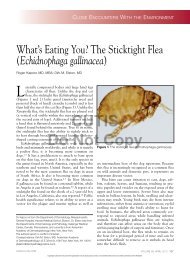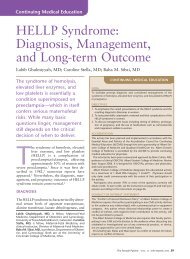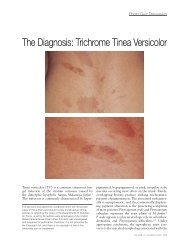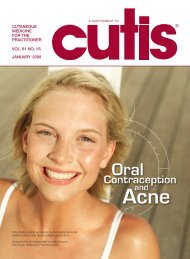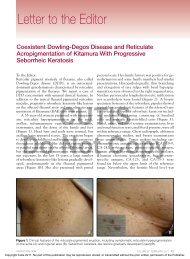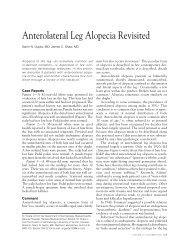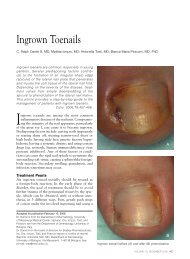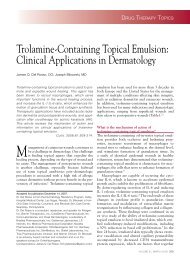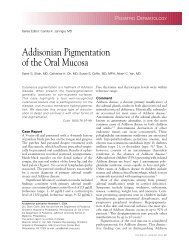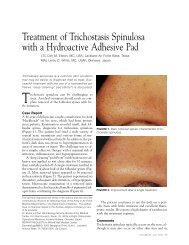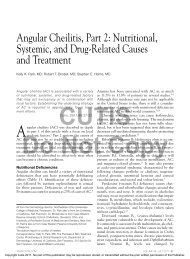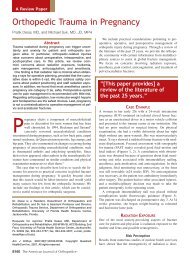Common Vulvar Disorders in Children
Common Vulvar Disorders in Children
Common Vulvar Disorders in Children
You also want an ePaper? Increase the reach of your titles
YUMPU automatically turns print PDFs into web optimized ePapers that Google loves.
CONTRIBUTED BYNORTH AMERICAN SOCIETY FORPEDIATRIC AND ADOLESCENT GYNECOLOGYADOLESCENTGYNECOLOGY<strong>Common</strong> <strong>Vulvar</strong> <strong>Disorders</strong><strong>in</strong> <strong>Children</strong>Ellen S. Rome, MD, MPHAny vulvovag<strong>in</strong>al symptoms <strong>in</strong> childrenusually raise the spectre ofsexual abuse or disease. However,most conditions are benign andeasily treated, and provide a“teachable moment” that demandsall due respect and effort.<strong>Vulvar</strong> disorders are fairly common<strong>in</strong> children, and require a specialapproach to evaluation and managementthat comb<strong>in</strong>es patiencewith an open manner that <strong>in</strong>spires trust <strong>in</strong>both patients and parents. This articledescribes common vulvar disorders (eg,vulvovag<strong>in</strong>itis, lichen sclerosis, “bubblebath”vag<strong>in</strong>itis). Sexual abuse⎯a subspecialty<strong>in</strong> itself⎯is not addressed here.VULVOVAGINAL EXAMINATION INCHILDRENVulvovag<strong>in</strong>al <strong>in</strong>spection should be a rout<strong>in</strong>epart of the pediatric well-child visit,but is often omitted. The prepubertal genitalexam<strong>in</strong>ation should be viewed as anopportunity to educate the girl and herparents about issues such as hygiene, preventivecare, correct anatomical terms forthe genitalia, protection of privacy, and“stranger danger.”Before provid<strong>in</strong>g gynecologic services forchildren, the cl<strong>in</strong>ician must create anappropriate environment. The wait<strong>in</strong>g areaand office should be “child-proofed”⎯eg, electric outlets covered, no scalpels orEllen S. Rome, MD, MPH, is Head, Section of AdolescentMedic<strong>in</strong>e, Cleveland Cl<strong>in</strong>ic, Cleveland, OH.scissors with<strong>in</strong> reach. Toys, games, andbooks should be available so that the childcan relax safely.HistoryWhen the genital exam<strong>in</strong>ationoccurs <strong>in</strong> the context of a problem,the parents may have fearsabout sexual abuse, cancer,potential <strong>in</strong>fertility, or otherhidden anxieties. The cl<strong>in</strong>icianshould ask the child directly ifshe has any concerns about herbody or her health; if the childlooks to the parent or caregiverfor guidance, questions can bedirected to the parent. The childshould be allowed to describeany symptoms. Specific questionsshould <strong>in</strong>clude symptomssuch as pa<strong>in</strong>, bleed<strong>in</strong>g, itch<strong>in</strong>g,odor, and discharge; duration ofsymptoms; past problems; and use ofbubble bath or perfumed body washes.If sexual abuse is a concern, the childshould be asked open-ended, nonjudgmentalquestions. Good eye contactshould be ma<strong>in</strong>ta<strong>in</strong>ed with the child toABOUT NASPAGThe North American Society for Pediatricand Adolescent Gynecology (NASPAG) isa nonprofit organization dedicated to educat<strong>in</strong>ghealth care professionals <strong>in</strong> pediatricand adolescent gynecology.For <strong>in</strong>formation, contact NASPAG:www.naspag.orgNASPAG1209 Montgomery HighwayBirm<strong>in</strong>gham, AL 35216-2809FOCUSPOINTAllow the childto describe hersymptoms, and askquestions aboutpa<strong>in</strong>, bleed<strong>in</strong>g,itch<strong>in</strong>g, odor,and discharge.The Female Patient | VOL 33 JANUARY 2008 51
Romethan <strong>in</strong> asymptomatic girls. 6 In a study ofgirls with vulvovag<strong>in</strong>itis aged 2 to 12 years,pathogenic bacteria were isolated <strong>in</strong> 36%of cases, and group A beta hemolytic streptococcuswas found <strong>in</strong> 59%. 7 Pathogenicbacteria (<strong>in</strong>clud<strong>in</strong>g Streptococcus pyogenes,Haemophilus <strong>in</strong>fluenzae, Staphylococcusaureus, Moraxella catarrhalis, Streptococcuspneumoniae, Neisseria men<strong>in</strong>gitides,Shigella, and Yers<strong>in</strong>ia entercolitica) correlatedwith the presence of leukocytes <strong>in</strong>vag<strong>in</strong>al secretions with a sensitivity of83% and a specificity of 59%. 1,7 Fewerpatients are present<strong>in</strong>g with H <strong>in</strong>fluenzaevag<strong>in</strong>itis today due to universal vacc<strong>in</strong>ation.Vag<strong>in</strong>al colonization with Escherichiacoli has been found <strong>in</strong> 36% of girls present<strong>in</strong>gwith vag<strong>in</strong>itis and <strong>in</strong> 23% of asymptomaticgirls 8 ; 90% of girls younger thanage 3 had vag<strong>in</strong>al E coli, compared with15% of asymptomatic girls aged 3 to 10years. 9 One case has been reported <strong>in</strong>volv<strong>in</strong>ga prepubertal girl with vulvovag<strong>in</strong>itiscaused by antibiotic-resistant Shigellaflexneri. 10 Cultures should be obta<strong>in</strong>ed forbloody discharge us<strong>in</strong>g a nasopharyngealswab moistened with nonbacteriostaticsal<strong>in</strong>e solution. 10,11 A positive f<strong>in</strong>d<strong>in</strong>g mayrepresent colonization rather than true<strong>in</strong>fection: the latter is more likely when oneorganism predom<strong>in</strong>ates. Non<strong>in</strong>fectiouscauses are more common <strong>in</strong> prepubertalgirls, <strong>in</strong> whom <strong>in</strong>fections are typicallyassociated with more severe <strong>in</strong>flammationand vag<strong>in</strong>al discharge. 12 Treatment usuallyconsists of sitz baths and removal of offend<strong>in</strong>gagents such as bubble bath, ammonia,or bleach <strong>in</strong> the tub.Foreign bodies are the most commoncause of vag<strong>in</strong>al bleed<strong>in</strong>g <strong>in</strong> children. Vulvovag<strong>in</strong>itis,lichen sclerosis, precociouspuberty, urethral prolapse, hemangioma,and tumor are other possibilities. In thepresence of bleed<strong>in</strong>g, the history should<strong>in</strong>clude trauma, hematuria, rectal bleed<strong>in</strong>g,symptoms of vag<strong>in</strong>itis, pubertal development,and potential abuse. In a childyounger than age 7, bleed<strong>in</strong>g with acceleratedl<strong>in</strong>ear growth may <strong>in</strong>dicate precociouspuberty. Patients with thrombocytopeniamay have vag<strong>in</strong>al bleed<strong>in</strong>g, as well as petechiae,easy bruis<strong>in</strong>g, or epistaxis. 3OTHER VULVOVAGINAL DISORDERSIN CHILDRENLichen Sclerosis et AtrophicusAssociated with hypoestrogenism, lichensclerosis can occur <strong>in</strong> prepubertal childrenand postmenopausal women. Girls maypresent with itch<strong>in</strong>g, vag<strong>in</strong>al or per<strong>in</strong>ealbleed<strong>in</strong>g, soreness, dysuria, and (rarely)constipation. Classic f<strong>in</strong>d<strong>in</strong>gs <strong>in</strong>clude an“hourglass” or “figure-eight” demarcationof hypopigmented sk<strong>in</strong> from above the clitoristo the anus and scattered telangiectasia,with or without per<strong>in</strong>eal fissur<strong>in</strong>g.Treatment consists of midpotency or strongertopical corticosteroids, us<strong>in</strong>g the loweststeroid dosage that provides relief. Midpotencyoptions <strong>in</strong>clude hydrocortisone valerate,0.2%, while fluoc<strong>in</strong>onide, 0.05%, is ahigher-potency choice. For rarecases requir<strong>in</strong>g a super-potent steroid,clobetasol propionate, 0.05%,or halobetasol propionate, 0.05%,may be used. Creams tend to st<strong>in</strong>gmore than o<strong>in</strong>tments, and emollientssuch as diaper o<strong>in</strong>tmentsand petroleum jelly can be appliedas well. The steroid cream is usuallyapplied spar<strong>in</strong>gly twice dailyfor 2 weeks, then once daily for 2 to4 weeks, and then every other dayfor 2 weeks. Chronic use of topicalsteroids can lead to atrophy, telangiectasias,striae, hypopigmentation,and super<strong>in</strong>fection (fungal orviral), so the cl<strong>in</strong>ician must educatethe parents and closely followthese patients.Atopic DermatitisSome children may be overly sensitive tospecific diaper brands, diaper creams, orwipes. They commonly present with abrightly erythematous per<strong>in</strong>eum, butwithout the satellite lesions seen withCandida. Usually, a simple brand changewill suffice, but <strong>in</strong> extreme cases, the parentcan be advised to use water ratherthan commercially available wipes. Atopicdermatitis tends to spare the “diaperarea,” aid<strong>in</strong>g <strong>in</strong> diagnosis. Super<strong>in</strong>fectionwith S aureus or Streptococcus sp mayFOCUSPOINTLichen sclerosiscan occur <strong>in</strong> prepubertalchildren and istreated with topicalcorticosteroids, butthe patient must befollowed closely.The Female Patient | VOL 33 JANUARY 2008 53
Romeoccur if the child scratches, but S aureus<strong>in</strong>fections rarely <strong>in</strong>volve the vag<strong>in</strong>a. 13 Useof emollients, hypoallergenic soaps, andpossibly 1% hydrocortisone cream mayhelp relieve symptoms.Psoriasis<strong>Children</strong> are more likely than adults tohave psoriasis <strong>in</strong> the vulvar area. It maypresent as an itchy, well demarcated, nonscaly,brightly erythematous, symmetricalplaque <strong>in</strong>volv<strong>in</strong>g the vulva, per<strong>in</strong>eum, andgluteal folds. Nail pitt<strong>in</strong>g, posterior auricularerythema, or rash with scal<strong>in</strong>g <strong>in</strong> otherareas may occur as well. Treatment <strong>in</strong>volveslow-potency or midpotency topical corticosteroids,us<strong>in</strong>g the lowest effective dosage.Concurrent <strong>in</strong>fection should beexcluded. Low-dose topical steroids maybe needed for ma<strong>in</strong>tenance therapy.Systemic DiseasesInfectious mononucleosis and other systemicillnesses may present with vulvarf<strong>in</strong>d<strong>in</strong>gs, and vulvar ulcers can mimicherpes simplex virus. 13,14 <strong>Children</strong> withKawasaki syndrome or Stephens-Johnsonsyndrome may have desquamation ofthe per<strong>in</strong>eum. Crohn’s disease tends toaffect the perianal area. Behcet diseasemay present first as vulvovag<strong>in</strong>itis; oralapthous ulcers may be followed by genitalulcers, with ocular symptoms <strong>in</strong> the teenageyears. 13,15,16 The parent or child mayfear a sexually transmitted <strong>in</strong>fection <strong>in</strong>these cases. Acrodermatitis enteropathicamay occur with z<strong>in</strong>c deficiency, present<strong>in</strong>gwith lateral crack<strong>in</strong>g of the lips/mouthand an eroded, bilateral vulvar rash with awell demarcated edge. 17TumorsAlthough rare, genital tumors should beconsidered <strong>in</strong> any child present<strong>in</strong>g withchronic genital ulceration, nontraumaticswell<strong>in</strong>g of the external genitalia, a vag<strong>in</strong>almass, foul-smell<strong>in</strong>g or bloody discharge,and no evidence of a foreign body,virilization, or precocious puberty. Botyroidsarcoma of the vag<strong>in</strong>a has a peak<strong>in</strong>cidence at age 2, and 90% of cases occur<strong>in</strong> children younger than age 5. This tumoris often found <strong>in</strong> the lower vag<strong>in</strong>a <strong>in</strong> youngchildren, and <strong>in</strong> the upper vag<strong>in</strong>a/cervix<strong>in</strong> children older than age 10. 13 Orig<strong>in</strong>at<strong>in</strong>g<strong>in</strong> the lam<strong>in</strong>a propria from undifferentiatedmesenchyme, this tumor spreadsrapidly below the vag<strong>in</strong>al epithelium to<strong>in</strong>filtrate the vag<strong>in</strong>al wall. It may appearas a cluster of “grapes,” bulg<strong>in</strong>g outwardwith polypoid growths conta<strong>in</strong><strong>in</strong>g edematousstroma and dilated blood vessels.Treatment consists of chemotherapy withor without radiation therapy and conservativesurgery, with a survival rate of 80%to 90% <strong>in</strong> girls with localized pelvic rhabdomyosarcoma.3,18,19 Other rare f<strong>in</strong>d<strong>in</strong>gs<strong>in</strong>clude vulvar malignant melanoma,Langerhans cell histocytosis,congenital per<strong>in</strong>eal lipoma,condyloma acum<strong>in</strong>atum, andprolapsed ectopic ureterocoele.Labial AdhesionsLabial adhesions are relativelycommon <strong>in</strong> babies and children,sometimes with secondary dermatitisfrom pool<strong>in</strong>g ur<strong>in</strong>e or vag<strong>in</strong>alsecretions due to adhesionsabove the urethra that extend pastthe vag<strong>in</strong>a. Ur<strong>in</strong>ary tract <strong>in</strong>fectionsmay rarely occur with adhesions.Labial adhesions usuallybother the parent more than thechild, but are easily treatable with topicalestrogen cream applied directly to the areadaily <strong>in</strong> very small amounts. Althoughadhesions often recur, asymptomaticadhesions do not require treatment.CONCLUSION<strong>Vulvar</strong> dermatologic problems <strong>in</strong> childrencan provide an excellent opportunity forreassurance, education, and discussion,enhanc<strong>in</strong>g communication for parent,child, and cl<strong>in</strong>ician. With simple officetools and proper position<strong>in</strong>g, foreign bodies,<strong>in</strong>fections, and systemic disease arereadily identified and managed. In childrenwith vulvovag<strong>in</strong>itis, simple rules fordiagnosis and treatment apply: the presenceof pus warrants cultur<strong>in</strong>g; abscessesshould be <strong>in</strong>cised and dra<strong>in</strong>ed; anysystemic and/or topical treatment optionFOCUSPOINT<strong>Children</strong> are morelikely than adultsto have psoriasis<strong>in</strong> the vulvar area.Tumors are rare, butlabial adhesionsare common.The Female Patient | VOL 33 JANUARY 2008 57
ADOLESCENTGYNECOLOGY<strong>Common</strong> <strong>Vulvar</strong> <strong>Disorders</strong> <strong>in</strong> <strong>Children</strong>should be considered, as appropriate; andsitz baths should be recommended to helprelieve symptoms.REFERENCES1. Emans SJ, Laufer MR, Goldste<strong>in</strong> DP, eds. Pediatricand Adolescent Gynecology, 5th ed. Philadelphia,PA: Lipp<strong>in</strong>cott Williams & Wilk<strong>in</strong>s;2005:1-15, 83-119.2. Pokorny SF, Stormer J. Atraumatic removal ofsecretions from the prepubertal vag<strong>in</strong>a. Am JObstet Gynecol. 1987;156(3):581-582.3. Emans SJ, Goldste<strong>in</strong> DP. The gynecologic exam<strong>in</strong>ationof the prepubertal child with vulvovag<strong>in</strong>itis:use of the knee-chest position. Pediatrics.1980;65(4):758-760.4. Heller RH, Joseph JM, David HJ. Vulvovag<strong>in</strong>itis<strong>in</strong> the premenarchal child. J Pediatr. 1969;74(3):370-377.5. Piippo S, Lenko H, Vuento R. <strong>Vulvar</strong> symptoms<strong>in</strong> paediatric and adolescent patients. Acta Paediatr.2000;89(4):431-435.6. Stricker T, Navratil F, Sennhauser FH. Vulvovag<strong>in</strong>itis<strong>in</strong> prepubertal girls. Arch Dis Child.2003;88(4):324-326.7. Emans SJ, Woods ER, Allred EN, Grace E.Hymenal f<strong>in</strong>d<strong>in</strong>gs <strong>in</strong> adolescent women: impactof tampon use and consensual sexual activity. JPediatr. 1994;125(1):153-160.8. Alexander ER. Misidentification of sexuallytransmitted organisms <strong>in</strong> children: medicolegalimplications. Pediatr Infec Dis J. 1988;7(1):1-2.9. Whitt<strong>in</strong>gton WL, Rice RJ, Biddle JW, Knapp JS.Incorrect identification of Neisseria gonorrhoeaefrom <strong>in</strong>fants and children. Pediatr Infect Dis J.1988;7(1):3-10.10. Johnson RE, Newhall WJ, Papp JR, Knapp JS,Black CM, Gift TL, et al. Screen<strong>in</strong>g tests to detectChlamydia trachomatis and Neisseria gonorrhoeae<strong>in</strong>fections⎯2002. MMWR Recomm Rep.2002;51(RR-15):1-38.11. Sexually transmitted diseases treatment guidel<strong>in</strong>es2002. Centers for Disease Control and Prevention.MMWR Recomm Rep. 2002;51(RR-6):1-78.12. Paradise JE, Campos JM, Friedman HM, FrishmuthG. Vulvovag<strong>in</strong>itis <strong>in</strong> premenarchal girls:cl<strong>in</strong>ical features and diagnostic evaluation.Pediatrics. 1982;70(2):193-198.13. Mroueh J, Muram D. <strong>Common</strong> problems <strong>in</strong> pediatricgynecology: new developments. Curr Op<strong>in</strong>Obstet Gynecol. 1999;11(5):463-446.14. Sisson BA, Glick L. Genital ulceration as a present<strong>in</strong>gmanifestation of <strong>in</strong>fectious mononucleosis.J Pediatr Adolesc Gynecol. 1998;11(4):185-187.15. Uziel Y, Brik R, Padeh S, et al. Juvenile Behcet’sdisease <strong>in</strong> Israel. The Pediatric RheumatologyStudy Group of Israel. Cl<strong>in</strong> Exp Rheumatol.1998;16(4):502-505.16. Eldem B, Onur C, Ozen S. Cl<strong>in</strong>ical features ofpediatric Behçet’s disease. J Pediatr OphthalmolStrabismus. 1998;35(3):159-161.17. Fischer GO. Vulval disease <strong>in</strong> pre-pubertal girls.Australas J Dermatol. 2001;42(4):225-234.18. Copeland LJ, Gershenson DM, Saul PB, Sneige N,Str<strong>in</strong>ger CA, Edwards CL. Sarcoma botyroides ofthe female genital tract. Obstet Gynecol. 1985;66(2);262-266.19. Arndt CA, Donaldson SS, Anderson RJ, et al.What constitutes optimal therapy for patientswith rhabomyosarcoma of the female genitaltract? Cancer. 2001;91(12): 2454-2468.Have you seen an <strong>in</strong>terest<strong>in</strong>g case<strong>in</strong> your practice recently?We <strong>in</strong>vite you to write it up andsubmit it to our Case Reportdepartment. Please <strong>in</strong>clude anyrelevant images, and email the caseto carol.saunders@QHC.com.Please see our author guidel<strong>in</strong>esat www.femalepatient.comfor further <strong>in</strong>formation.58 The Female Patient | VOL 33 JANUARY 2008



